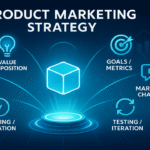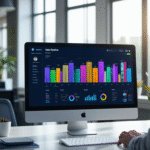Now Reading: Sales Pipeline Roadmap: Proven Steps for Predictable Growth
-
01
Sales Pipeline Roadmap: Proven Steps for Predictable Growth

Sales Pipeline Roadmap: Proven Steps for Predictable Growth
Introduction
A well-structured sales pipeline is the cornerstone of predictable revenue and scalable growth. Whether you’re a founder flying solo or leading a large team, knowing how to build a sales pipeline roadmap empowers you to track prospects, forecast accurately, and optimize every stage. This guide walks you through each pipeline stage, actionable tactics to fill and move deals, key metrics to monitor, and advanced tools to streamline workflows. By following these proven steps, you’ll transform scattered leads into a reliable, repeatable sales engine.
Why a Sales Pipeline Matters
A clear pipeline provides visibility into deal status, enabling timely interventions and data-driven decisions. Without one, teams chase random leads, struggle with inaccurate forecasts, and burn out from reactive firefighting. In contrast, a defined pipeline aligns marketing and sales, highlights bottlenecks, improves forecasting accuracy, and scales smoothly as your team grows. Investing in a robust pipeline turns unpredictable sales cycles into a reliable growth machine.
Foundational Preparations Before You Begin
Before mapping stages, ensure you have:
- Ideal Customer Profiles (ICPs): Detailed buyer personas outlining industry, company size, role, and buying triggers.
- Lead Sources Inventory: A list of all channels generating inquiries—website forms, ads, referrals, events, and cold outreach.
- Documented Sales Process: Step-by-step actions for moving prospects from interest to close.
- CRM or Pipeline Tool: A centralized system (e.g., HubSpot, Salesforce) to track deals, activities, and outcomes.
With these in place, you can align each customer journey step to measurable milestones.
Stage 1: Prospecting and Lead Generation
Fill your top of funnel by capturing and qualifying leads. Tactics include LinkedIn outreach, content offers, webinars, and paid ads. Track weekly new leads entering this stage to gauge funnel health and adjust outreach channels accordingly.
Stage 2: Initial Contact and Qualification
Within 48 hours, make first contact via call or email to confirm fit using frameworks like BANT or MEDDIC. Assign a qualification score, and disqualify unfit leads to keep the pipeline fresh and focused.
Stage 3: Needs Assessment and Demo
Schedule discovery calls or demos for qualified prospects. Use a custom agenda to uncover pain points, goals, decision criteria, and timeline. A tailored demo can boost conversion rates by over 30%.
Stage 4: Proposal and Negotiation
After alignment on needs, send a bespoke proposal highlighting ROI, pricing tiers, and timelines. Proactively address common objections—budget, integrations, timeline—and offer flexible options to maintain momentum.
Stage 5: Commitment and Close
Finalize contracts and obtain signatures. Automate reminders for expiring proposals and follow up within 24 hours to reduce “proposal ghosting” and accelerate deal closure.
Stage 6: Onboarding and Upsell
Ensure a smooth handoff to customer success for onboarding. Regular check-ins and value reviews lay the groundwork for renewals and upsells, often generating the highest margins.
Assign Activities and Owners
Success requires clear tasks and accountability at each stage. For example:
- SDRs send 50 personalized outreach emails per week and log responses.
- AEs conduct 5 tailored demos weekly and record key insights.
- Customer Success Managers schedule onboarding calls within 48 hours of close.
Defining owners and KPIs prevents deals from stalling and ensures consistent follow-up.
Key Metrics to Monitor
Track these metrics weekly or monthly:
- Lead Velocity Rate: Growth rate of new leads entering the pipeline.
- Conversion Rate per Stage: Percentage of deals moving to the next stage.
- Average Deal Size: Forecast revenue from current pipeline.
- Sales Cycle Length: Time from prospecting to close.
- Pipeline Coverage: Total pipeline value divided by revenue target (aim for 3× coverage).
Dashboards in your CRM make it easy to spot trends and take corrective action.
Optimize and Iterate
Continuously refine your pipeline by:
- Adjusting qualification criteria to balance volume and quality.
- Tweaking outreach cadence based on response analytics.
- Producing more high-impact content assets for each stage.
- Conducting win/loss analyses and coaching based on call recordings.
- Holding monthly pipeline reviews with sales, marketing, and customer success.
Advanced Tools & Automation
Leverage these tools to accelerate pipeline performance:
- CRM Automation: Use HubSpot or Salesforce workflows to auto-assign leads and send follow-up sequences.
- Sales Engagement Platforms: Outreach or SalesLoft manage multi-channel cadences and track engagement.
- Conversational Intelligence: Gong or Chorus analyze calls to extract winning keywords and objection patterns.
- Predictive Analytics: Use AI lead scoring (e.g., 6sense) to rank prospects by fit and intent, boosting SDR efficiency by 30%.
Tips & Best Practices
- Maintain Pipeline Hygiene: Disqualify stale deals monthly to keep data clean.
- Align with Marketing: Define lead handoff SLAs to ensure seamless transitions.
- Use Visual Pipeline Views: Kanban-style boards offer clear deal status at a glance.
- Implement Sales Playbooks: Standardize messaging, objection handling, and battlecards.
- Celebrate Milestones: Recognize reps who hit stage-specific KPIs to boost morale.
Conclusion
Building a sales pipeline roadmap with these proven steps empowers you to drive predictable revenue and sustainable growth. Define clear stages, assign responsibilities, track key metrics, and leverage automation to create a repeatable sales engine. Start implementing this roadmap today and watch your sales performance soar.
References
- A Guide to the Sales Pipeline — Benefits, Stages, and More – https://business.adobe.com/blog/basics/sales-pipeline
- What Are the Stages of a Sales Pipeline? – https://www.salesforce.com/ca/sales/pipeline/stages/
- How to Build an Effective Sales Pipeline – https://monday.com/blog/crm-and-sales/sales-pipeline-stages/
- What Is a Sales Pipeline? How to Build One Successfully? – https://www.freshworks.com/crm/sales/sales-pipeline/
- Sales Pipelines: A Comprehensive Guide for Sales Leaders and Reps – https://blog.hubspot.com/sales/sales-pipeline
















Anonymous
There is an enduring quality to this text. It speaks not only to the moment of reading but to ongoing reflection, becoming richer with each encounter.
Shashi M.
Thank you for such a thoughtful reflection — that means a great deal. Creating content with lasting resonance is always the north star, so hearing that it continues to spark deeper insight over time is incredibly encouraging.
If any particular idea in the piece keeps resurfacing for you — or if you’d like to explore the theme through an even broader strategic lens — I’m always here to continue the conversation and build on that momentum.
Binance
Your article helped me a lot, is there any more related content? Thanks!